A key Japanese government committee has approved a joint Japanese/European mission to the planet Mercury. BepiColombo, named after the late Italian astronomer who worked on the previous mission to Mercury, is expected to launch in 2010 and will contain an orbiter and a lander which will penetrate the surface of the planet. The European Space Agency had committed to the project three years ago, but the Japanese government has yet to supply its share of the funds. This will be the first mission to Mercury since Mariner 10, which went in the 1970s.
Antenna Problems on SOHO
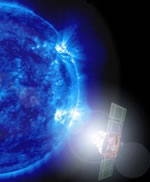
Image credit: ESA
The NASA/ESA SOHO spacecraft, which observes the Sun, is having problems pointing its high-gain antenna, which it uses to transmit data back to Earth. The cause of the problem hasn’t been figured out yet, but experts think there’s something wrong with its motor or in the gear assembly that steers the antenna – fortunately, its low-gain antenna is still working, so they can still communicate with the spacecraft. If they can’t figure out the problem, SOHO isn’t going to be able to transmit data back as quickly, so there will be blackout periods.
The ESA/NASA SOHO spacecraft, launched in 1995, has been delivering outstanding data about the Sun for over eight years. Recently, however, an anomaly on the pointing mechanism of its high-gain antenna has been recorded.
The high-gain antenna is required to transmit the large amounts of data from SOHO’s scientific observations to Earth. From SOHO’s orbit, the antenna has to be pointed in the proper direction – like a flashlight – for the data to be received at Earth.
The exact nature of the antenna problem is not yet known, but the experts think that a malfunction has occurred in its motor or in the gear assembly that steers the antenna.
SOHO is safe, as the spacecraft has a low-gain antenna, used to control the spacecraft and monitor both spacecraft and instrument health and safety, which remains operational. However, if the high-gain antenna problem persists, there will be periodic losses in the real-time transmission of scientific data of about two and a half weeks each three months. The first blackout is estimated to begin sometime late in the week of 22 June 2003.
A number of options are currently being investigated by the SOHO team to fully recover or minimise any real-time scientific data loss. A joint ESA/NASA press release will follow shortly.
Original Source: ESA News Release
Stardust Completes Course Correction
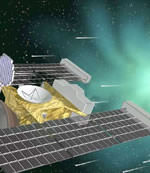
Image credit: NASA
NASA’s Stardust probe completed a minor course correction on Thursday, now only 198 days away from its destination: Comet Wild 2. The spacecraft fired its thrusters for 24 minutes and used up nearly 10% of its fuel. Stardust has traveled 2.9 billion kilometres since its launch in 1999, and if all goes well, it will reach the comet in January, 2004 and capture particles from its tail. It will then return the samples to Earth so they can be studied on the ground by scientists.
With 198 days before its historic rendezvous with a comet, NASA’s Stardust spacecraft successfully completed the mission?s third deep space maneuver. This critical maneuver modified the spacecraft?s trajectory, placing it on a path to encounter and collect dust samples from comet Wild 2 in January 2004.
At 2100 Universal Time (2:00 p.m. Pacific Time), Wed., June 18, Stardust fired its eight, 4.4 newton (1 pound) thrusters for a grand total of 1456 seconds, changing the comet sampler?s speed by 34.4 meters per second (about 77 miles per hour). This burn, the second in two days, completed the almost seven-year-long mission?s third deep space maneuver. The June 18 burn required 6.08 kilograms (13.4 pounds) of hydrazine monopropellant to complete. At launch, the spacecraft carried 85 kilograms (187 pounds) of hydrazine propellant.
“It was a textbook maneuver,” said Robert Ryan, Stardust?s mission manager at NASA?s Jet Propulsion Laboratory, Pasadena, Calif. “This was the last big burn we will have prior to our encounter with Wild 2, and it looks very accurate. After sifting through all the post-burn data I expect we will find ourselves right on the money.”
Stardust has traveled over 2.9 billion kilometers (1.8 billion miles) since its February 7, 1999 launch. At present, it is hurtling through the cosmos at 124,300 kilometers per hour (77,200 miles per hour).
In January 2004, Stardust will fly through the halo of dust that surrounds the nucleus of comet Wild 2. The spacecraft will return to Earth in January 2006 to make a soft landing at the U.S. Air Force Utah Test and Training Range. Its sample return capsule, holding microscopic particles of comet and interstellar dust, will be taken to the planetary material curatorial facility at NASA’s Johnson Space Center, Houston, Texas, where the samples will be carefully stored and examined.
Stardust?s cometary and interstellar dust samples will help provide answers to fundamental questions about the origins of the solar system. More information on the Stardust mission is available at http://stardust.jpl.nasa.gov.
Stardust, a part of NASA’s Discovery Program of low-cost, highly focused science missions, was built by Lockheed Martin Astronautics and Operations, Denver, Colo., and is managed by the Jet Propulsion Laboratory, Pasadena, Calif., for NASA’s Office of Space Science, Washington, D.C. JPL is a division of the California Institute of Technology in Pasadena. The principal investigator is astronomy professor Donald E. Brownlee of the University of Washington in Seattle.
Original Source: NASA News Release
ESA’s Rosetta Gets a New Target
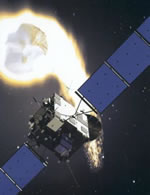
Image credit: ESA
The comet-chasing spacecraft Rosetta has been given a new comet to chase: Comet Churyumov-Gerasimenko. The European Space Agency announced on Wednesday that the spacecraft will now be launched in February 2004, and it will rendezvous with the comet in November 2014. Rosetta was originally supposed to launch earlier this year, but it was delayed after an Ariane 5 rocket failed to launch its satellite payload – Rosetta was held back to give investigation teams time to determine what called the failure, and lost its launch window for Comet Wirtanen.
Comet-chasing mission Rosetta will now set its sights on Comet Churyumov-Gerasimenko. During its meeting on 13-14th May 2003, ESA’s Science Programme Committee decided Rosetta’s new mission baseline.
The spacecraft will be launched in February 2004 from Kourou, French Guiana, using an Ariane-5 G+ launcher. The rendezvous with the new target comet is expected in November 2014.
The choice of a new comet has required intensive efforts, including observations by telescopes such as the Hubble Space Telescope and the ESO Very Large Telescope to ensure we know as much as we can about the new target. The cost of the Rosetta launch delay is estimated at round 70 million Euros. The ESA Ministerial Council has resolved the financial issue by approving financial flexibility at Agency level.
Scientists will now investigate an alternative launch to this comet, in February 2005, as a back-up plan. Rendezvous with the comet is expected in November 2014.
Once again, Europe is set to try to do something no-one has ever done before – to chase and catch a comet.
Original Source: ESA News Release
Rosetta Will Have to Be Dismantled
Now that Rosetta has been delayed indefinitely from its original mission to visit Comet Wirtanen, technicians have to dismantle the spacecraft and return each scientific instrument to the researchers who built them. The mission was cancelled because a recent report indicated that the Ariane 5 rocket was unsafe to launch. Rosetta’s original target was Comet Schwassmann-Wachmann 3, then Comet Wirtanen, so now planners are considering Comets Finlay, Brooks 2 and Wild 2. There’s no scheduled launch date, though.
Rosetta Launch Postponed Indefinitely
Just a day after they announced that Rosetta could be flying by the end of the month, the European Space Agency decided to put the mission on hold indefinitely because of their concerns with the Ariane-5 rocket. Unfortunately, since Rosetta won’t be launching by the end of the month, it won’t be able to meet up with Comet Wirtanen. by 2011, so the entire mission will need to be redesigned to seek a new target.
Rosetta Due for Late January Launch
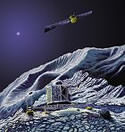
Image credit: ESA
The European Space Agency’s Rosetta mission will be the first spacecraft to ever orbit and then land on a distant comet. Scheduled for launch on board an Ariane-5 rocket as early as January 22, the spacecraft will rendezvous with Comet Wirtanen in 2011. There is some uncertainty about the launch, however, because of a booster accident with an enhanced Ariane-5 last month. The spacecraft must launch by the end of January if it’s to meet up with Wirtanen; otherwise, a new objective will have to be selected.
ESA’s Rosetta will be the first mission to orbit and land on a comet. Comets are icy bodies that travel throughout the Solar System and develop a characteristic tail when they approach the Sun. Rosetta is scheduled to be launched on-board an Ariane-5 rocket in January 2003 from Kourou, French Guiana.
The decision on the launch date will be taken by Tuesday 14 January 2003 (See Arianspace’s press release number 03/02 of 7 January 2003 or look at the web site http://www.arianespace.com). The mission target is Comet Wirtanen and the encounter will occur in 2011. Rosetta’s name comes from the famous Rosetta Stone that, almost 200 years ago, led to the deciphering of Egyptian hieroglyphics. In a similar way, scientists hope that the Rosetta spacecraft will unlock the mysteries of the Solar System.
Comets are very interesting objects for scientists since their composition reflects how the Solar System was when it was very young and still ‘unfinished’, more than 4600 million years ago. Comets have not changed much since then. By orbiting Comet Wirtanen and landing on it, Rosetta will collect essential information to understand the origin and evolution of our Solar System. It will also help discover whether comets contributed to the beginnings of life on Earth. Comets are carriers of complex organic molecules that, when delivered to Earth through impacts, perhaps played a role in the origin of living forms. Furthermore, ‘volatile’ light elements carried by comets may have also played an important role in forming the Earth’s oceans and atmosphere.
“Rosetta is one of the most challenging missions ever undertaken so far,” says Prof. David Southwood, ESA Director of Science. “No one before has attempted a simular mission, unique for its scientific implications as well as for its complex and spectacular interplanetary space manoeuvres.” Before reaching its target in 2011, Rosetta will circle the Sun almost four times on wide loops in the inner Solar System. During its long trek, the spacecraft will have to endure some extreme thermal conditions. Once it is close to Comet Wirtanen, scientists will take it through a delicate braking manoeuvre; then the spacecraft will closely orbit the comet, and gently drop a lander on it. It will be like landing on a small, fast-moving cosmic bullet that has, at present, an almost unknown ‘geography’.
An amazing 8-year interplanetary trek
Rosetta is a 3-tonne box-type spacecraft about 3 metres high, with two 14-metre long solar panels. It consists of an orbiter and a lander. The lander is approximately 1 metre across and 80 centimetres high. It will be attached to the side of the Rosetta orbiter during the journey to Comet Wirtanen. Rosetta carries 21 experiments in total, 10 of them on the lander. They will be kept in hibernation during most of its 8-year trek towards Wirtanen.
What makes Rosetta’s cruise so long? At the time of the rendezvous, Comet Wirtanen will be as far from the Sun as Jupiter is. No launcher could possibly get Rosetta there directly. ESA’s spacecraft will gather speed from gravitational ‘kicks’ provided by three planetary fly-bys: one of Mars in 2005 and two of Earth in 2005 and 2007. During the trip, Rosetta will also visit two asteroids, Otawara (in 2006) and Siwa (in 2008). During these encounters, scientists will switch on Rosetta’s instruments for calibration and scientific studies.
Long trips in deep space include many hazards, such as extreme changes in temperature. Rosetta will leave the benign environment of near-Earth space for the dark, frigid regions beyond the asteroid belt. To manage these thermal loads, experts have done very tough pre-launch tests to study Rosetta’s endurance. For example, they have heated its external surfaces to more than 150 degrees Celsius, then quickly cooled it to -180 degrees Celsius in the next test.
Scientists will fully reactivate the spacecraft prior to the comet rendezvous manoeuvre in 2011. Then, Rosetta will orbit the comet, an object only 1.2 kilometres wide, while it cruises through the inner Solar System at 135 000 kilometres per hour. At the time of the rendezvous, around 675 million kilometres from the Sun, Wirtanen will hardly show any surface activity. The characteristic coma (the comet’s ‘atmosphere’) and the tail will not yet have formed because of the large distance from the Sun. The comet’s tail is made up of dust grains and frozen gases from the comet’s surface that vapourise because of the Sun’s heat.
For six months, Rosetta will extensively map the comet surface, prior to selecting a landing site. In July 2012, the lander will self-eject from the spacecraft from a height of just one kilometre. Touchdown will take place at walking speed – less than 1 metre per second. Immediately after touchdown, the lander will fire a harpoon into the ground to avoid bouncing off the surface back into space. It has to do this because the comet’s extremely weak gravity alone will not hold onto the lander. Operation and scientific observations on the comet surface will last 65 hours as a minimum, but may continue for many months.
During and after the lander operations, Rosetta will continue orbiting and studying the comet. Rosetta will be the first spacecraft to witness at close quarters the changes taking place in a comet when the comet approaches the Sun and grows its coma and tail. The trip will end in July 2013, after 10.5 years of adventure, when the comet is closest to the Sun.
Studying a comet on the spot
Rosetta’s goal is to examine a comet in great detail. The instruments on Rosetta’s orbiter include several cameras, spectrometers, and experiments that work at different wavelengths – infrared, ultraviolet, microwave, radio – and a number of sensors. They will provide, among other things, very high-resolution images and information about the shape, density, temperature, and chemical composition of the comet. Rosetta’s instruments will analyse the gases and dust grains in the so-called coma that forms when the comet becomes active, as well as the interaction with the solar wind.
The 10 instruments on board the lander will do an on-the-spot analysis of the composition and structure of the comet’s surface and subsurface material. A drilling system will take samples down to 30 centimetres below the surface and will feed these to the ‘composition analysers’. Other instruments will measure properties such as the near-surface strength, density, texture, porosity, ice phases, and thermal properties. Microscopic studies of individual grains will tell us about the texture. In addition, instruments on the lander will study how the comet changes during the day-night cycle, and while it approaches the Sun.
Ground operations
Data from the lander are relayed to the orbiter, which stores them for downlink to Earth at the next ground station contact. ESA has installed a new deep-space antenna at New Norcia, near Perth in Western Australia, as the main communications link between the spacecraft and the ESOC Mission Control in Darmstadt, Germany. This 35-metre diameter parabolic antenna allows the radio signal to reach distances of more than 1 million kilometres from Earth. The radio signals, travelling at the speed of light, will take up to 50 minutes to cover the distance between the spacecraft and Earth.
Rosetta’s Science Operations Centre, which is responsible for collecting and distributing the scientific data, will share a location at ESOC and ESTEC in Noordwijk, The Netherlands. The Lander Control Centre is located in DLR in Cologne, Germany, and the Lander Science Centre in CNES in Toulouse, France.
Building Rosetta
Rosetta was selected as a mission in 1993. The spacecraft has been built by Astrium Germany as prime contractor. Major subcontractors are Astrium UK (spacecraft platform), Astrium France (spacecraft avionics), and Alenia Spazio (assembly, integration, and verification). Rosetta’s industrial team involves more than 50 contractors from 14 European countries and the United States.
Scientific consortia from institutes across Europe and the United States have provided the instruments on the orbiter. A European consortium under the leadership of the German Aerospace Research Institute (DLR) has provided the lander. Rosetta has cost ESA Euro 701 million at 2000 economic conditions. This amount includes the launch and the entire period of development and mission operations from 1996 to 2013. The lander and the experiments, the so-called ‘payload’, are not included since they are funded by the member states through the scientific institutes.
Comet Chasing Spacecraft Delivered to Spaceport
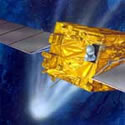
Image credit: ESA
The European Space Agency’s Rosetta spacecraft was shipped to the Kourou spaceport in French Guiana in preparation for its launch early next year. The spacecraft contains 20 different scientific instruments designed to help study comets. It will lift off January 13, and then spend nine years in space; hurtling past two asteroids, Mars, Earth twice and finally arrive at comet Wirtanen. It will approach the comet and get as close as one kilometre.
Twenty instruments on the European Space Agency’s comet-chasing Rosetta spacecraft, including three from NASA, are in final tests for launch early next year.
Launch from the Kourou spaceport in French Guiana, on the northeastern coast of South America, is scheduled for a 19-day window beginning Jan. 13, 2003. Shipment to Kourou last month from the European Space Research and Technology Centre in Noordwijk, the Netherlands, followed more than 10 months of rigorous testing. “With the move from Europe to Kourou, we have now entered the most exciting phase of the Rosetta program so far — the launch campaign,” said Claude Berner, Rosetta’s payload and assembly, integration and verification manager.
NASA is funding three research instruments and a key part of a fourth for the collaborative mission. NASA also provides one of the Rosetta’s interdisciplinary scientists, Dr. Paul Weissman, of NASA’s Jet Propulsion Laboratory, Pasadena, Calif., and operational support from JPL’s Deep Space Network of ground-based antennas. “Rosetta is an ambitious mission with great international cooperation,” said JPL’s Dr. Claudia Alexander, project scientist for the U.S. role in the mission. “We’re eager to get it launched.”
Rosetta will fly for nearly nine years, passing by two asteroids, by Earth twice and by Mars before reaching its destination, comet Wirtanen, in November 2011. At that point, the comet will be about four times as far from the Sun as Earth is. Then, as Rosetta orbits Wirtanen at distances as close as one kilometer (0.6 mile), the orbiter’s instruments will examine how the comet changes while it moves closer to the Sun during the following 20 months. Rosetta will also drop a lander onto the surface of Wirtanen’s icy nucleus. The NASA instruments will examine Wirtanen from the orbiter. International teams of scientists expect to see dramatic changes as the comet approaches the Sun. Gases and dust escaping from the surface of a comet form a cloud-like “coma” around the nucleus and a tail pointing away from the Sun.
Rosetta carries more instruments than any other spacecraft in history. The orbiter’s payload includes a camera to study surface details, a microscope to analyze dust grains coming off the nucleus, spectrometers to examine surface and coma materials in various wavelengths, and an experiment to probe the comet’s interior with radio waves.
With all instruments installed, the spacecraft was put through its paces during testing at the European Space Research and Technology Centre. It was placed in a large vacuum chamber while the instruments were tested in heat and cold simulating the extremes the spacecraft will experience when it is closest to the Sun and when it will be almost as distant as Jupiter. Vibration and acoustic tests demonstrated that the whole spacecraft can survive a launch environment. Another set of tests checked whether any instruments cause electromagnetic interference with any others. Verification of many essential functions included commanding the spacecraft from the European Space Operations Centre in Germany, just as it will be in orbit. At Kourou, each instrument will again be tested by itself and with the other instruments before engineers can finally declare everything “green” for launch.
JPL supplied the Microwave Instrument for Rosetta Orbiter, the first of its type for any interplanetary mission. This instrument can reveal the abundances of selected gases, their temperatures, the speed at which they’re coming off the nucleus, and the temperature of the nucleus. Scientists will use it to monitor changes in how vapors are released from the nucleus as the coma and tail grow. They will be studying water, carbon monoxide, ammonia and methanol gases, four of the most abundant gases from comets. JPL’s Dr. Samuel Gulkis is principal investigator.
The Southwest Research Institute, based in San Antonio, Texas, supplied two NASA instruments for Rosetta. One is named Alice. It is the first in a new generation of miniaturized ultraviolet spectrometers and is capable of analyzing the composition both of gases released by the comet and of the comet’s surface. One goal of scientists using it will be to learn about the temperatures at which the comet formed and evolved by determining its abundances of noble gases, such as helium, neon and argon. Principal investigator for the ultraviolet instrument is Dr. Alan Stern of the institute’s Space Studies Department in Boulder, Colo.
Dr. James Burch, of the institute’s Instrumentation and Space Research Division, San Antonio, is principal investigator for Rosetta’s Ion and Electron Spectrometer. This device will measure the environment of charged particles surrounding comet Wirtanen. It will also study the interaction between that environment and the solar wind of charged particles speeding outward from the Sun.
Key electronics for a fourth instrument, the Rosetta Orbiter Spectrometer for Ion and Neutral Analysis, have been supplied by the Lockheed Martin Advanced Technology Center, Palo Alto, Calif. This instrument will examine gases surrounding the comet.
Information is available about Rosetta at http://sci.esa.int/rosetta and about the microwave instrument at http://mirowww.jpl.nasa.gov. JPL, a division of the California Institute of Technology in Pasadena, manages the microwave instrument for NASA’s Office of Space Science, Washington, D.C.
Original Source: NASA News Release
NASA Loses Comet Chasing Spacecraft
NASA scientists haven’t given up hope in their search for the missing Contour spacecraft, which disappeared shortly after it was supposed to fire its thrusters on Thursday. A telescope captured an image of two separate objects, moving in the direction Contour was supposed to be headed, leading to speculation that the spacecraft broke in two, but this hasn’t been confirmed yet. Had it worked properly, Contour would now be on its way to meet up with two comets to take high resolution photos of their nuclei.
Cassini Camera Working Fine Again
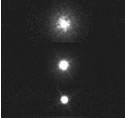
Image credit: NASA
Controllers for the Cassini spacecraft received some good news last week when the latest set of test images came through showing no distortion in its camera system. They became worried last year when haze appeared on the camera after it was heated briefly in a maintenance operation – the haze diffused 70% of the light reaching the camera. Controllers slowly heated and cooled the spacecraft several times, and now the distortion is down to 5%. Cassini will begin orbiting Saturn on July 1, 2004 and it will deliver the piggybacked Huygens probe into the atmosphere of Titan.
Now within two years of reaching Saturn, NASA’s Cassini spacecraft took test images of a star last week that reveal successful results from an extended warming treatment to remove haze that collected on a camera lens last year.
The quality of the new images is virtually the same as star images taken before the haze appeared. In the most recent treatment, the camera had been warmed to 4 degrees Celsius (39 degrees Fahrenheit) for four weeks ending July 9. Four previous treatments at that temperature for varying lengths of time had already removed most of the haze. The camera usually operates at minus 90 C (minus 130 F), one of the temperatures at which test images were taken on July 9 of the star Spica.
“We’re happy with what we’re seeing now,” said Robert Mitchell, Cassini program manager at NASA’s Jet Propulsion Laboratory, Pasadena, Calif. The team will decide in coming weeks whether to proceed with another warming treatment later this year.
Cassini’s narrow-angle camera worked flawlessly for several months before and after a December 2000 flyby of Jupiter. Haze appeared when the camera cooled back to its usual operating temperature after a routine-maintenance heating to 30 C (86F) in mid-2001. Lens hazing from engine exhaust or other sources is always a possibility on interplanetary spacecraft. Planners designed heaters for Cassini’s cameras to cope with just such a situation.
Before treatment, the haze diffused about 70 percent of light coming from a star, by one method of quantifying the problem. Now, the comparable diffusion is about 5 percent, Cassini engineers Charles Avis and Vance Haemmerle report. That’s within one percent of what was seen in images from before the hazing occurred, possibly within the range of statistical noise in the analysis. Comparison images are posted at http://www.jpl.nasa.gov/images/cassinicamera_caption.html.
Additional information about Cassini-Huygens is online at http://saturn.jpl.nasa.gov.
Cassini will begin orbiting Saturn on July 1, 2004, and release its piggybacked Huygens probe about six months later for descent through the thick atmosphere of the moon Titan. Cassini-Huygens is a cooperative mission of NASA, the European Space Agency and the Italian Space Agency. JPL, a division of the California Institute of Technology in Pasadena, manages the mission for NASA’s Office of Space Science, Washington, D.C.
Original Source: NASA/JPL News Release
